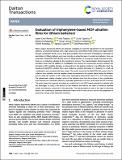Por favor, use este identificador para citar o enlazar a este item:
http://hdl.handle.net/10261/337724COMPARTIR / EXPORTAR:
 SHARE SHARE
 CORE
BASE CORE
BASE
|
|
| Visualizar otros formatos: MARC | Dublin Core | RDF | ORE | MODS | METS | DIDL | DATACITE | |

| Título: | Evaluation of triphenylene-based MOF ultrathin films for lithium batteries |
Autor: | Ciria-Ramos, Isabel CSIC ORCID; Tejedor, Inés CSIC ORCID; Caparros, Lucía; Doñagueda, Beatriz; Lacruz, Oscar CSIC; Urtizberea, Ainhoa CSIC ORCID; Roubeau, Olivier CSIC ORCID; Gascón, Ignacio CSIC ORCID; Haro Remón, Marta CSIC ORCID | Fecha de publicación: | 2023 | Editor: | Royal Society of Chemistry (UK) | Citación: | Dalton Transactions 52(21): 7196-7207 (2023) | Resumen: | Metal–organic frameworks (MOFs) are attractive candidates to meet the requirement of next-generation batteries, as functional materials with a high surface area, well-defined metal centers, and organic linkers through coordination bonds. Due to their great tunability, MOFs have been investigated as electrodes or electrolytes in lithium batteries and more recently as protective layers in anode-less batteries. Here, we synthesize a Ni3(HHTP)2 MOF directly at the air–liquid interface of a Langmuir trough and grow the electrode on a conductive substrate by the transference process. The characterization during Langmuir film formation shows that the addition of crystallization time during the compression process enhances the formation of 2D crystalline domains, as observed by in situ grazing-incidence X-ray diffraction. Next, the transferred Ni3(HHTP)2 ultrathin films were studied as working electrodes in Li batteries in a half-cell configuration and compared with bare copper. The results show that the Ni3(HHTP)2 film protects the Cu collector from oxidation, and the negative charge accumulates in the organic ligand during the lithiation process while NiII oxidizes to NiIII, unlike other triphenylene-based MOFs with CuII or CoII metal nodes. The galvanostatic plating–stripping cycles of the batteries show that the inclusion of the crystallization time improves the coulombic efficiency, especially significantly in the first cycles when the SEI is formed. This work shows the Langmuir technique as a useful tool to test MOF based materials for batteries with the advantages of using a low amount of raw materials and without the need to introduce additives (binder and electron conductor) in the electrodes. The electrochemical study of this type of electrode allows a first screening to synthesize electrodes based on MOFs and can be a tool for the preparation of protective coatings under optimized conditions. | Versión del editor: | https://doi.org/10.1039/D3DT00876B | URI: | http://hdl.handle.net/10261/337724 | DOI: | 10.1039/D3DT00876B | ISSN: | 1477-9234 |
| Aparece en las colecciones: | (INMA) Artículos |
Ficheros en este ítem:
| Fichero | Descripción | Tamaño | Formato | |
|---|---|---|---|---|
| evaluatbatteries.pdf | 2,39 MB | Adobe PDF |  Visualizar/Abrir |
CORE Recommender
Page view(s)
24
checked on 21-may-2024
Download(s)
17
checked on 21-may-2024
Google ScholarTM
Check
Altmetric
Altmetric
Este item está licenciado bajo una Licencia Creative Commons

